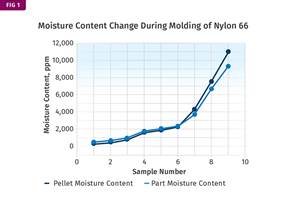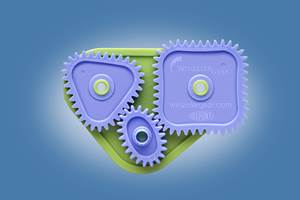Nylon Oil Sump Gets Its Start in Trucks
Integrated nylon oil sumps for a new line of trucks made by Mercedes-Benz have begun to roll down German autobahns, paving the way for a potential torrent of conversions from aluminum, steel, and thermosets to thermoplastics.
Integrated nylon oil sumps for a new line of trucks made by Mercedes-Benz have begun to roll down German autobahns, paving the way for a potential torrent of conversions from aluminum, steel, and thermosets to thermoplastics. The 13.2-lb part has been adopted for a V6 diesel engine upgrade in a new Actros truck line. The molder is Kunstofftechnik Sachsen GmbH in Ottendorf-Okrilla, Germany.
The sumps are molded out of Ultramid A3HG7, a 35% glass-reinforced nylon 66 from BASF. The resin supplier reports that several nylon oil-sump programs are in progress in the U.S. and are expected to hit the road in the next year. "This is the first known case of a reinforced nylon oil pan being adopted for trucks, and it suggests that their role will grow," declares Mark Minnichelli, BASF Corp.’s director for commercial technology. Nylon sumps are typically about half the weight of aluminum versions. Industry sources note that earlier initiatives in thermoplastic oil sumps were aimed at cars and were long since discontinued. They say those previous efforts failed to survive attack by oils, high engine temperatures, and flying stones.
Minnichelli notes that virtually all oil sumps are still in aluminum or steel. However, the Actros truck program involved a running conversion of a thermoset sump to thermoplastic. The Ludwigshafen, Germany-based development team had to work with the existing under-hood space and bolting system, yet also found ways to increase the 30-liter sump’s volume by 30%. The nylon oil sump also integrates the oil sensors and dip stick into the design.
A 33-ton injection tool was designed for the project with complex slides to incorporate undercuts and a single gate to control fiber orientation. Proprietary BASF software for predictingglass orientation was used to create ribs and tailored glass orientation zones at the bolt line to get parts that would stay warp and leak resistant over lengthy warranty periods. Parts must pass tests involving long-term contact with hot oil at 120 C and excursions to 150 C.
Engine noise generated by the sump is also said to be less than with the thermoset version that was replaced. BASF credits this to its expertise in fine-tuning acoustics without use of mineral reinforcements that typically impair mechanical properties.
Structural sumps next?
Scott Schlicker, BASF’s manager of advanced development, categorizes some 80% of oil sumps as structural in the sense of requiring a significant degree of load-bearing (torsional) strength to carry the engine weight and contribute to crash-worthiness. He says the initial nylon truck sump falls within the 20% non-structural market sector where thermoplastics are most likely to make early inroads. Schlicker expects thermoplastic nylons to penetrate the non-structural sector mostly through parts integration—incorporating oil pumps, filters, pickup devices, baffles, and windage trays into the sump. That would eliminate parts and assembly steps and help to reduce overall costs.
For the next several years, inroads against aluminum and steel in structural oil sumps are likely to be modest. But BASF and competitor Rhodia Engineering Plastics are convinced that plastic-metal hybrid parts based on reinforced nylons are going to break into this market. The high strength-to-weight ratio of hybrid structures, such as those using BASF’s patented collar-joining method, is going to drive penetration, Schlicker predicts.
Meanwhile, suppliers of vinyl ester BMCs say the materials have excellent prospects in oil sumps. "We expect to challenge nylons for metal replacement in various under-hood and under-body applications, including oil sumps," states Wil Conner, automotive market development manager at Bulk Molding Compounds Inc. He says BMCs have advantages in the critical areas of warpage resistance and noise-suppression. A study by Market Search in Toledo, Ohio, projects rapid growth of vinyl ester BMC oil pans in the U.S.
Related Content
Resins & Additives for Sustainability in Vehicles, Electronics, Packaging & Medical
Material suppliers have been stepping up with resins and additives for the ‘circular economy,’ ranging from mechanically or chemically recycled to biobased content.
Read MoreWhat's the Allowable Moisture Content in Nylons? It Depends: Part 2
Operating within guidelines from material suppliers can produce levels of polymer degradation. Get around it with better control over either the temperature of the melt or the barrel residence time.
Read MoreTracing the History of Polymeric Materials: Acetal
The road from discovery in the lab to commercial viability can be long, and this was certainly the case for acetal polymers.
Read MoreTracing the History of Polymeric Materials: Aliphatic Polyketone
Aliphatic polyketone is a material that gets little attention but is similar in chemistry to nylons, polyesters and acetals.
Read MoreRead Next
How Polymer Melts in Single-Screw Extruders
Understanding how polymer melts in a single-screw extruder could help you optimize your screw design to eliminate defect-causing solid polymer fragments.
Read MoreProcessor Turns to AI to Help Keep Machines Humming
At captive processor McConkey, a new generation of artificial intelligence models, highlighted by ChatGPT, is helping it wade through the shortage of skilled labor and keep its production lines churning out good parts.
Read MoreAdvanced Recycling: Beyond Pyrolysis
Consumer-product brand owners increasingly see advanced chemical recycling as a necessary complement to mechanical recycling if they are to meet ambitious goals for a circular economy in the next decade. Dozens of technology providers are developing new technologies to overcome the limitations of existing pyrolysis methods and to commercialize various alternative approaches to chemical recycling of plastics.
Read More

























